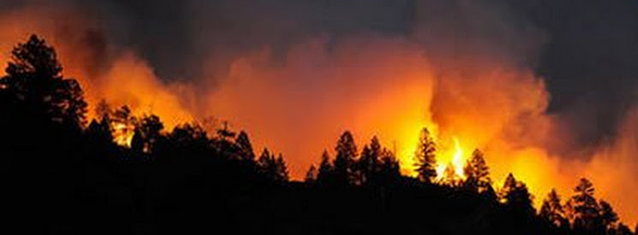
Photo by Matt Peart
As the human population grows, city boundaries expand and neighborhoods push into undeveloped terrain. This space, where wildland mixes with infrastructure, is called the wildland-urban interface (WUI). Neighborhoods in the WUI have a greater chance of being affected by fire because they contain larger amounts of plant landscaping, other abundant fuel sources, and structures that could sustain a fire.
Though people can never fully protect their homes against wildfires, you can take steps to reduce the risk. A good rule is to create a safety zone of low fuel density around the home. For example:
- Remove combustible vegetation from around any structure, according to local ordinances. Thin out continuous tree and brush cover and remove dead limbs, fallen trees, leaves, twigs, and pine cones.
- Prune tree branches to 10 feet above the ground and remove leaves and twigs from beneath trees, in the yard, on roofs, patios, and landscaped shrubs.
- Do not use highly flammable landscaping near structures, such as bark or wood chip mulch.
- Stack firewood uphill at least 15 feet from a house. Fire risks increase when wooden decks, patios, and woodpiles are placed close to structures.
- Roofs and walls made of untreated flammable materials, such as wood shakes and shingles, pose a significant fire threat. Wind-carried embers can ignite those fuel sources.
- Clean roof and gutters to prevent buildup of debris.
- Mow tall grass and keep it to a maximum height of two inches.
- Inspect and clean chimneys regularly. Equip chimneys for wood burning units with spark arresters.
- Avoid all outdoor burning.
- Prevent mishaps with outdoor cooking grills by carefully maintaining the grill and using caution during grill use.
Fire Info for You
Employees
Are you concerned about brush, grass, or forest fires where you live? Use this flyer to learn more about Firewise principles and find immediate, simple steps and resources that can help residents reduce the risk of wildfire damage.
Park Leadership
Is your park effectively mitigating the WUI fire hazards in park housing and around work buildings? If not, use the principles discussed above to create a WUI fire hazard assessment and mitigation plan.
Take Action
- Investigate JUST ONE interactive module below to quickly become Firewise!
- Dynamics of Wildfire
- Explore a Firewise Home
- Firewise Hints: How You Can Be Firewise
- Operation Water
- Peak Fire Seasons
- Preparing a Home for Wildfire Season
- Wildfire Approaching
- Prioritize the actions that you can take to make your home safer from wildland fire and do one of them on your weekend.
- If you live in park housing, report wildland fire safety concerns to your supervisor.
NPS Fire Facts
Some wildland fires occur in sparsely populated areas and are managed to remain within park or forest boundaries. Wildland fires can be beneficial. They reduce fuel loads, such as dead standing or fallen limbs, logs, leaves, pine needles, shrubs, and excess grass. Such periodic burning reduces the intensity of fires that occur in subsequent years, decreasing the impact of fire on fire-tolerant plants and burrowing animals. If fuel loads are not reduced, the forest can become a fire hazard similar to a basement packed full of newspapers. When the fuel loads are reduced, undesired fires can be minimized.
Several national parks have developed specific curricula to help teach students about wildland fire and its role in park ecology.
Last updated: October 28, 2016
